从零开始搭建Vue3环境(vite+ts+vue-router),手拉手做一个router项目
搭建vue3环境
我们使用vite来搭建vue3环境(没有安装vite需要去安装vite)
npm create vite routerStudy
在命令行选择

cd routerStudy
npm i
npm run dev
环境搭建成功!!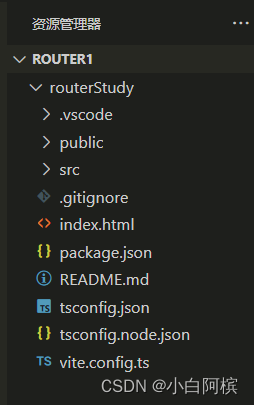
vue-router入门(宝宝模式)
- 下载vue-router
npm i vue-router@4
- 新建以下文件src/components/File1.vue:
<template><div>
这是文件一
</div></template><script setup lang="ts"></script><style scoped></style>
src/components/File2.vue:
<template><div>
这是文件二
</div></template><script setup lang="ts"></script><style scoped></style>
在src下新建router文件夹
在router文件夹下新建router.ts:
import{ createRouter,createWebHistory,createWebHashHistory }from'vue-router'import File1 from'../components/File1.vue'import File2 from'../components/File2.vue'const routes =[{
path:'/',
component:File1
},{
path:'/file2',
component:File2
}]const router =createRouter({// history: createWebHistory(),
history:createWebHashHistory(),
routes,})exportdefault router;
- 修改src/main.ts
import{ createApp }from'vue'import'./style.css'import App from'./App.vue'import router from'./router/router'createApp(App).use(router).mount('#app')
- 修改src/components/HelloWorld.vue:
<script setup lang="ts"></script><template><router-view/><button><router-link to="/">去文件一</router-link></button><button><router-link to="/file2">去文件二</router-link></button></template><style scoped></style>
- 点击按钮能够切换成功则使用成功

vue-router基础(青年模式)
一。动态路由匹配
1.带参数的动态路由匹配
当我们需要对每个用户加载同一个组件,但用户id不同。我们就需要在vue-router种使用一个动态字段来实现,再通过$routr.params来获取值:
我们用具体实例来实现一下:
(1)修改src/router/router.ts:
import{ createRouter,createWebHistory,createWebHashHistory }from'vue-router'import File1 from'../components/File1.vue'import File2 from'../components/File2.vue'const routes =[{
path:'/',
component:File1
},{
path:'/file2/:username/abc/:userid',//注意看这个
component:File2
}]const router =createRouter({
history:createWebHistory(),// history:createWebHashHistory(),
routes,})exportdefault router;
(2)修改组件HelloWorld.vue: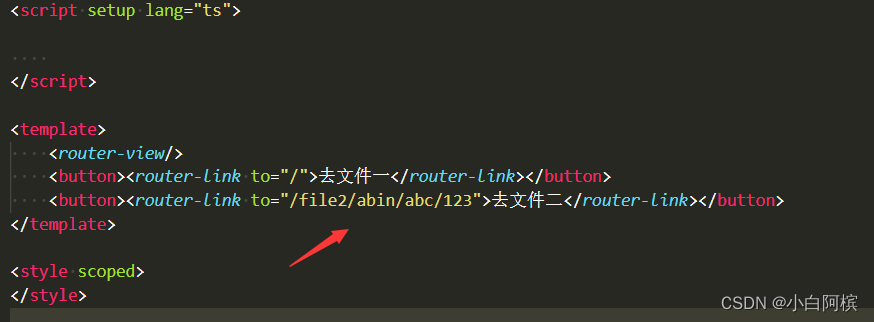
(3) 修改组件File2.vue:
<template><div>
这是文件二
</div></template><script setup lang="ts">import{getCurrentInstance,onMounted }from'vue'const instance =getCurrentInstance()if(instance !=null){const _this = instance.appContext.config.globalProperties //vue3获取当前thisonMounted(()=>{console.log(_this.$route.params)})}</script><style scoped></style>
(4)点击去文件二按钮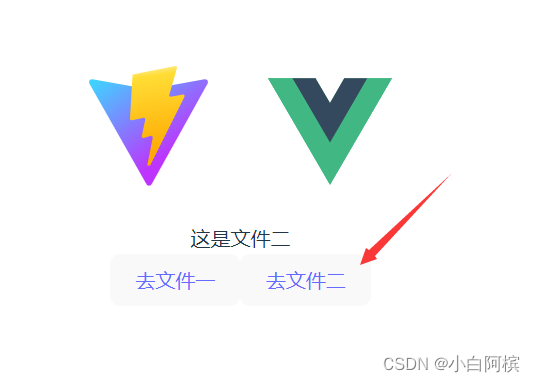
(5)查看控制台
2.捕获所有路由或404 Not Found路由
当用户在导航栏乱输一通后,路由表中没有对应的路由,这时候,就需要将用户转去404页面。那么
我们该如何处理呢?
(1)修改router/router.ts:
import{ createRouter,createWebHistory,createWebHashHistory }from'vue-router'import File1 from'../components/File1.vue'import File2 from'../components/File2.vue'import NotFound from'../components/NotFound.vue'import UserGeneric from'../components/UserGeneric.vue'const routes =[{
path:'/',
component:File1
},{
path:'/file2/:username/abc/:userid',
component:File2
},// 将匹配所有内容并将其放在 `$route.params.pathMatch` 下{
path:'/:pathMatch(.*)*', name:'NotFound', component: NotFound
},// 将匹配以 `/user-` 开头的所有内容,并将其放在 `$route.params.afterUser` 下{
path:'/user-:afterUser(.*)', component: UserGeneric
},]const router =createRouter({
history:createWebHistory(),// history:createWebHashHistory(),
routes,})exportdefault router;
(2)新建组件NotFound.vue:
<template><div>
糟糕!页面没有找到。。。呜呜呜
</div></template><script setup lang="ts">import{getCurrentInstance,onMounted }from'vue'const instance =getCurrentInstance()if(instance !=null){const _this = instance.appContext.config.globalProperties //vue3获取当前thisonMounted(()=>{console.log(_this.$route.params)})}</script><style scoped></style>
(3)修改HelloWorld.vue
(4)点击去404页面按钮(或者在地址栏乱写一通)

(5)出现404页面,说明运行成功!!!
二。嵌套路由
路由是可以嵌套的。例如: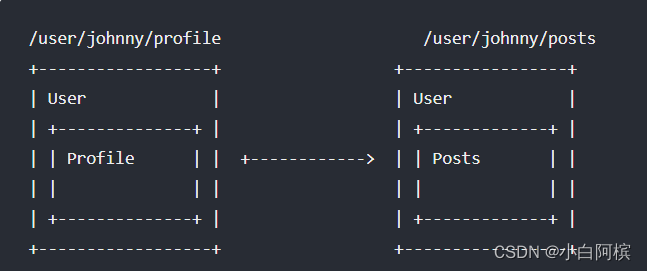
嵌套的理解挺简单的,我就不多叭叭了,直接上代码,看完就懂了。
(1)新建组件Children1.vue:
<template><div>
我是孩子1</div></template><script setup lang="ts"></script><style scoped></style>
(2)新建组件Children2.vue:
<template><div>
我是孩子2</div></template><script setup lang="ts"></script><style scoped></style>
(3)修改router/router.ts:
import{ createRouter,createWebHistory,createWebHashHistory }from'vue-router'import File1 from'../components/File1.vue'import File2 from'../components/File2.vue'import NotFound from'../components/NotFound.vue'import UserGeneric from'../components/UserGeneric.vue'import Children1 from'../components/Children1.vue'import Children2 from'../components/Children2.vue'const routes =[{
path:'/',
component: File1,},{
path:'/file2',
component: File2,
children:[//使用嵌套路由{
path:'children1',
component:Children1
},{
path:'children2',
component:Children2
},]},{
path:'/:pathMatch(.*)*', name:'NotFound', component: NotFound
},{
path:'/user-:afterUser(.*)', component: UserGeneric
},]const router =createRouter({
history:createWebHistory(),// history:createWebHashHistory(),
routes,})exportdefault router;
(4)修改组件HelloWorld.vue:
(5)修改组件File2.vue:
<template><div>
这是文件二
<div>
我是文件二里的内容
<router-view/><button><router-link to="/file2/children1">找孩子1</router-link></button><button><router-link to="/file2/children2">找孩子2</router-link></button></div></div></template><script setup lang="ts"></script><style scoped></style>
(6)先点去文件二,再点击找孩子1按钮,出现即成功!!
三。编程式导航
除了使用/< router-link/> 创建 a 标签来定义导航链接,我们还可以借助 router 的实例方法,通过编写代码来实现。
1.router.push()方法的使用
(1)修改组件NotFound.vue:
<template><div>
糟糕!页面没有找到。。。呜呜呜
</div></template><script setup lang="ts">import{getCurrentInstance,onMounted }from'vue'const instance =getCurrentInstance()if(instance !=null){const _this = instance.appContext.config.globalProperties //vue3获取当前this// 1.字符串路径
_this.$router.push('/file2/children2')// 2.带有路径的对象// _this.$router.push({path:'/file2/children2'})// 3.命名的路由,并加上参数,让路由建立 url// _this.$router.push({name:'file2',params:{username:'children2'}})// 4.带查询参数,结果是 /register?plan=private// _this.$router.push({ path: '/file2/children2', query: {userid:'123'} })onMounted(()=>{console.log(_this.$route.params)})}</script><style scoped></style>
(2)再点“去404页面”,发现没有去404页面了,说明编程式导航成功!!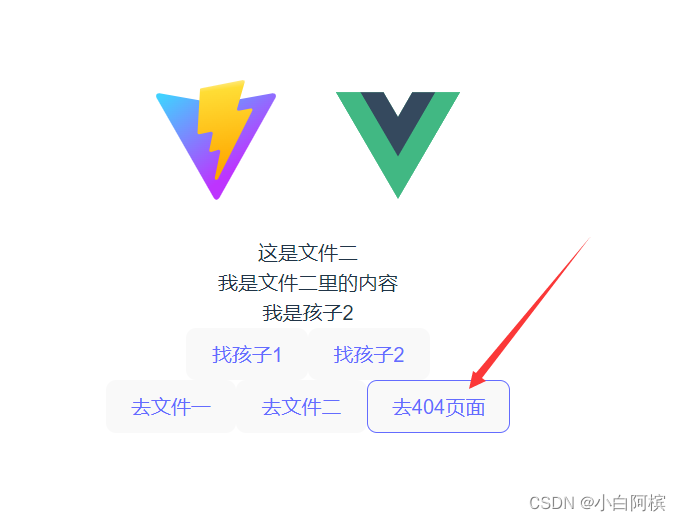
2.router.replace()方法的使用
它的作用类似于 router.push,唯一不同的是,它在导航时不会向 history 添加新记录,正如它的名字所暗示的那样——它取代了当前的条目。
修改组件NotFound.vue:
<template><div>
糟糕!页面没有找到。。。呜呜呜
</div></template><script setup lang="ts">import{getCurrentInstance,onMounted }from'vue'const instance =getCurrentInstance()if(instance !=null){const _this = instance.appContext.config.globalProperties //vue3获取当前this// 一。router.push的使用: // 1.字符串路径// _this.$router.push('/file2/children2')// 2.带有路径的对象// _this.$router.push({path:'/file2/children2'})// 3.命名的路由,并加上参数,让路由建立 url// _this.$router.push({name:'file2',params:{username:'children2'}})// 4.带查询参数,结果是 /register?plan=private// _this.$router.push({ path: '/file2/children2', query: {userid:'123'} })// 二。router.replace的使用:
_this.$router.replace('/file2/children1')onMounted(()=>{console.log(_this.$route.params)})}</script><style scoped></style>
3.router.go()方法的使用
修改组件NotFound.vue:
<template><div>
糟糕!页面没有找到。。。呜呜呜
</div></template><script setup lang="ts">import{getCurrentInstance,onMounted }from'vue'const instance =getCurrentInstance()if(instance !=null){const _this = instance.appContext.config.globalProperties //vue3获取当前this// 一。router.push的使用: // 1.字符串路径// _this.$router.push('/file2/children2')// 2.带有路径的对象// _this.$router.push({path:'/file2/children2'})// 3.命名的路由,并加上参数,让路由建立 url// _this.$router.push({name:'file2',params:{username:'children2'}})// 4.带查询参数,结果是 /register?plan=private// _this.$router.push({ path: '/file2/children2', query: {userid:'123'} })// 二。router.replace的使用:// _this.$router.replace('/file2/children1')// 三。router.go的使用:
_this.$router.go(-1)//相当于点击回退一次onMounted(()=>{console.log(_this.$route.params)})}</script><style scoped></style>
版权归原作者 小白阿槟 所有, 如有侵权,请联系我们删除。